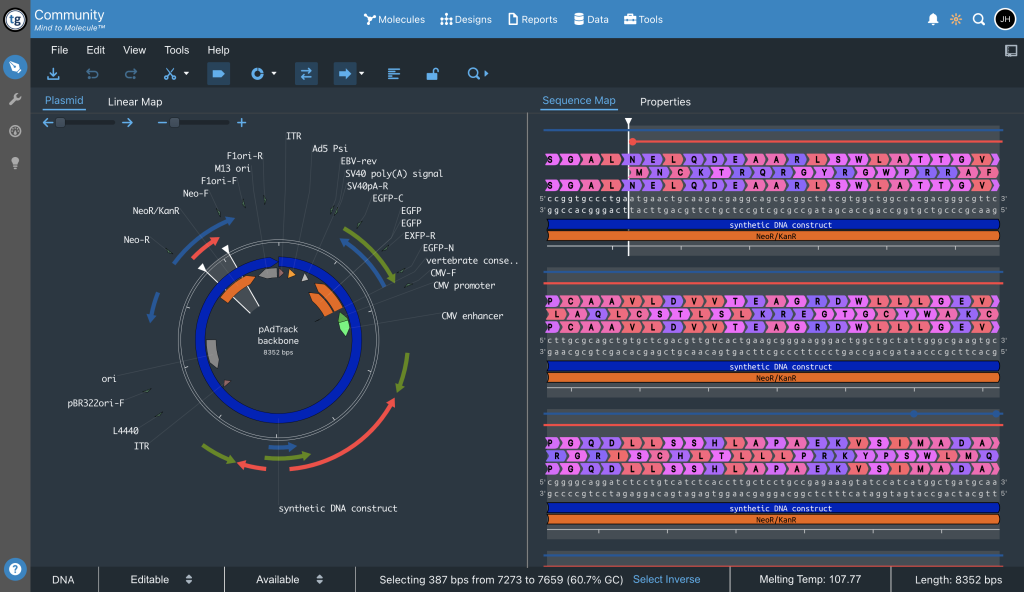Gene Therapy and Cell Therapy
Gene therapy is a rapidly evolving research field that aims to treat or cure genetic disorders by replacing, removing, or adding genetic material (i.e., DNA or RNA) into cells. One of the key tools used in gene therapy is viral vectors, which are engineered viruses that can deliver genetic material to cells.
Gene therapy is not the only type of therapy that can be used to treat genetic disorders or other diseases. Cell therapy is another promising area of research that aims to restore or replace damaged tissues or organs by using genetically modified stem cells. Stem cells have the unique ability to develop into many different types of cells in the body, making them a valuable tool for regenerative medicine.
Viral vectors can also be used in stem cell therapy to deliver genes that can promote differentiation or growth of specific cell types. For example, adeno-associated virus vectors have been used to deliver genes to mesenchymal stem cells for the treatment of bone and cartilage diseases.
Although gene therapy and cell therapy are different approaches to treating disease at the genetic level, both have the potential to revolutionize modern medicine and improve patient outcomes – and both rely on the development of efficacious viral vectors and genetic payloads. With the help of technologies like TeselaGen, a software platform for synthetic biology, researchers can design and optimize these vectors to enhance their safety and efficacy, ultimately bringing new treatments to patients faster and more efficiently.
In this post, we will discuss some of the most common viral vectors used in gene and cell therapy and their advantages and disadvantages.
1. Adenovirus
Used in Adenovirus gene therapy and cell therapy, this virus is a double-stranded DNA virus that can infect both dividing and non-dividing cells. It has a large cargo capacity of up to 36 kilobases (kb) and can efficiently transfer genes in vitro and in vivo. Adenovirus vectors have been used in cancer gene therapy and vaccine development. However, immune responses can limit long-term expression, and integration into the genome is rare.

2. Lentivirus
Lentivirus is a single-stranded RNA virus that is part of the retrovirus family. It has a maximum length of 8-10 kb and can stably express genes in both dividing and non-dividing cells. Lentivirus vectors can integrate into the host genome, allowing for long-term expression of the therapeutic gene. However, there is a potential for insertional mutagenesis, and the cargo capacity is limited. Lentivirus vectors have been used in the treatment of genetic disorders, HIV/AIDS, and cancer, including the revolutionary CAR-T cell therapy, which uses lentiviral vectors to genetically modify a patient’s T cells to target cancer cells.
3. Adeno-associated virus (AAV)
Used in AAV gene therapy and cell therapy, this virus is a single-stranded DNA virus that can infect both dividing and non-dividing cells. AAV vectors can integrate into a specific site in the host genome and are well-tolerated by the host, allowing for long-term expression of the therapeutic gene. However, the cargo capacity is limited (maximum genetic payload length of 4.7 kb), and immune responses can limit long-term expression. AAV vectors have been used in the treatment of genetic disorders and eye diseases.
4. Retrovirus
Retrovirus is a single-stranded RNA virus that can integrate into the host genome. It has a maximum length of 7-11 kb and can infect dividing cells. Retrovirus vectors have been used in the treatment of cancer, genetic disorders, and HIV/AIDS. However, integration can be random and cause insertional mutagenesis, and immune responses can limit long-term expression.
Summary of Common Viral Vectors Used in Gene Therapy and Cell Therapy
| Viral Vector | Virus Type | Length | Max Insertion Length | Advantages | Disadvantages | Applications | Addgene Link |
| Adenovirus | dsDNA | 36 kb | >8 kb | Efficient gene transfer in vitro and in vivo; can infect dividing and non-dividing cells; large cargo capacity | Immune response can limit long-term expression; integration into the genome is rare | Cancer gene therapy, vaccine development | Addgene: Adenovirus Plasmids |
| Lentivirus | ssRNA | 8-10 kb | ~8 kb | Stable long-term gene expression; can integrate into the host genome; can infect dividing and non-dividing cells | Cargo capacity is limited; potential for insertional mutagenesis | Genetic disorders, HIV/AIDS, cancer | Addgene: Lentiviral Guide |
| Adeno-associated virus (AAV) | ssDNA | 4.7 kb | ~4.5 kb | Safe and well-tolerated; can integrate into the host genome at a specific site; can infect both dividing and non-dividing cells | Limited cargo capacity; immune response can limit long-term expression | Genetic disorders, eye diseases | Addgene: Adeno-associated virus (AAV) Plasmids |
| Retrovirus | ssRNA | 7-11 kb | ~8 kb | Can integrate into the host genome; stable long-term expression; can infect dividing cells | Integration can be random and cause insertional mutagenesis; immune response can limit long-term expression | Cancer, genetic disorders, HIV/AIDS | Addgene: Retrovirus Plasmids |
Starting from the DNA (or RNA) sequences of viral vectors such as the ones described in this article, researchers can use TeselaGen to effortlessly design the genetic architecture of new viral vectors and automatically generate instructions for building these vectors using methods such as Golden Gate assembly and Gibson assembly. TeselaGen offers a sophisticated LIMS that includes physical inventory management and workflow management to fully support the construction of viral vectors and downstream quality control, including sequencing. In addition, the platform includes access to powerful machine learning models that can be used to close the design-build-test-learn cycle, providing researchers an efficient way to iterate on their designs. In summary, TeselaGen systematizes research and development processes, which reduces costs and time to market, and, most importantly, can help bring new treatments to patients faster.
If you’re interested in learning more about TeselaGen and how it can help you streamline your processes, we invite you to visit our website and request a demo. Our team is always happy to show researchers how our platform can help them accomplish their objectives, and we’re excited to help advance gene and cell therapies.
